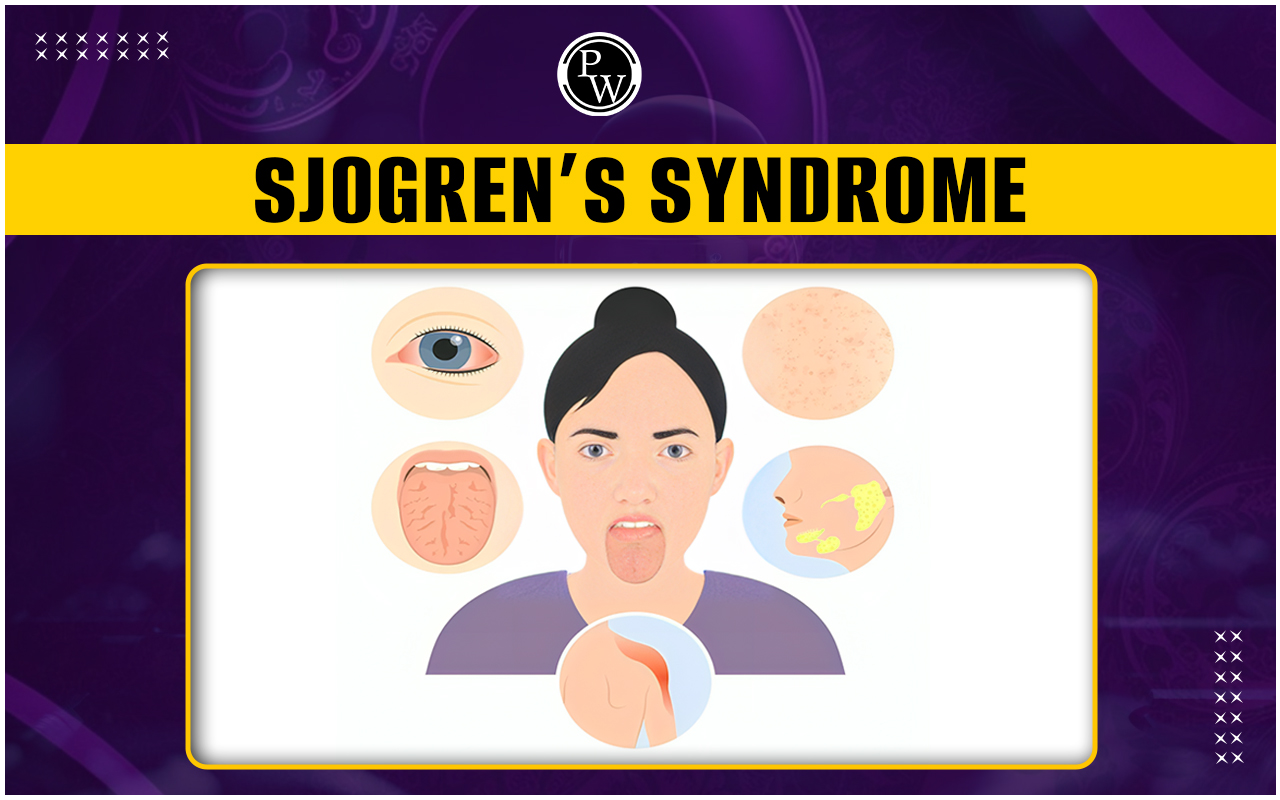

Sjogren's Syndrome is an immunity-related health disorder that develops when the glands in your body that create and regulate moisture are adversely affected. The most typical sign is persistent and unusual dryness in the lips and eyes.
Sjogren's Syndrome typically doesn't impact a person's general health or life expectancy. Problems may arise when the immune system targets other organs or tissues. It is a serious health issue, but proper treatment may reduce the likelihood of severe problems and complications.What is Sjogren's Syndrome?
Sjogren's Syndrome is an autoimmune disease. This indicates that it is a type of condition that arises when the immune system attacks the body's tissues and organs. The white blood cells in the blood, which are ordinarily there to defend us against infections, attack the glands responsible for producing moisture. As a result, the mouth, eyes, and other body parts become dry because the glands are unable to generate saliva and tears.Symptoms of Sjogren's Syndrome
The symptoms of Sjogren's Syndrome could be one, two, or several, and they differ from person to person. The most prevalent indicators of Sjogren's Syndrome are as follows:- Dryness in the mouth: A dry mouth is a common symptom that could feel gritty or harsh. One may face difficulty swallowing or even speaking. In the long term, this can lead to oral infections like candidiasis, cavities, and other dental issues.
- Dryness of eyes: Another symptom is dryness in the eyes that gives a burning or itching sensation. It may also cause blurred vision or sensitivity to light.
Some Sjogren' Syndromes may also give rise to one or more of the following symptoms:
- Stiffness, swelling, and joint pain
- Enlarged salivary glands, especially those in front of your ears and below your jaw
- Dryness of the skin and rashes on the skin
- Dryness in the nose, throat, and lips
- Dryness in the vagina
- Persistent dry cough
- Numbness in the arms and legs
- Burning sensation on the chest
- Headache and muscle pains
- A change in taste or smell
- Difficulty breathing
- Feeling exhausted
Causes of Sjogren's Syndrome
Sjogren Syndrome is the outcome of a disorder when your immune system targets functional tissues and cells and damages them. The exact causes of Sjogren's Syndrome are still unknown to scientists. An infection with a specific virus or bacteria may be the triggering factor that misdirects the white blood cells to attack the glands. Additionally, certain genetic factors can also increase an individual's of developing the condition. Your immune system targets the salivary and tear glands first when you have Sjogren's Syndrome However, it can harm other bodily organs as well.Diagnosis of Sjogren's Syndrome
Diagnosis of Sjogren's Syndrome can be difficult because the signs and symptoms vary in individuals and often resemble those of other diseases. Doctors conduct tests to identify and diagnose the presence of Sjogren's Syndrome and rule out other illnesses. The clinical examinations may include the following:Blood Examinations :
Your physician may prescribe blood tests to look for:- Quantity of various blood cell types
- Common antibodies associated with Sjogren's Syndrome
- Indications of inflammatory diseases
- Problems with your kidneys or liver
Eye Tests:
- The Schirmer tear test is an effective way of finding dryness in your eyes. It involves placing a little piece of filter paper beneath your lower eyelid to gauge how many tears you produce.
- An ophthalmologist may also use a magnification instrument called a slit lamp to inspect the surface of your eyes.
Imaging:
This method helps to assess the function of your salivary glands.- Sialogram: A dye is injected into the salivary glands in front of your ears, and a particular imaging technique is used to identify the amount of saliva that enters your mouth.
- Scintigraphy: In this particular medicine test, a radioactive material is injected into a vein, and its distribution to your salivary glands is monitored for a specific time
- Biopsy: In order to identify the existence of inflammatory cell clusters that might cause Sjogren's Syndrome, the doctor may take out a tiny piece of tissue from your salivary glands and examine it under a microscope.
Treatment of Sjogren's Syndrome
The treatment of Sjogren's Syndrome is mainly based on the nature of the damage to body parts. Using eye drops and drinking extra water are common ways that patients with Sjogren's Syndrome manage dryness in the mouth and eyes. However, in extreme cases, some people may require medications or even surgery.Medications
- Your eye doctor may prescribe eye drops to moisten your eyes if you have moderate to severe dryness in the eyes.
- Some medicines, like cevimeline (Evoxac) and pilocarpine (Salagen), might be helpful in increasing saliva and tears.
- To address specific issues like arthritis, nonsteroidal anti-inflammatory drugs (NSAIDs) can be effective.
- A medicine used to treat malaria, like hydroxychloroquine or Plaquenil, is also beneficial in treating SSjogren's disease.
- Medication that suppresses the immune system, including methotrexate, may also be recommended.
Surgery
There is an effective surgical procedure called punctual occlusion that can increase the flow of tears and give relief from dry eyes. The tear ducts are filled with silicone or collagen plugs to help retain your tears.Risk Factors for Sjogren's Syndrome
The risk factors associated with Sjogren's Syndrome are as follows:- Age: Sjogren's Syndrome typically affects people 40 years of age and older, while it can sometimes strike younger people, including children.
- Gender: The risk of developing Sjogren's Syndrome in women is up to ten times higher than in men. The impact that sex hormones have on an immune system could be connected to this imbalance.
- Existence of rheumatic disease: Sjogren's Syndrome is more likely to occur in a person who has a rheumatic disease, such as lupus or rheumatoid arthritis.
Why do people suffering from Sjogren's Syndrome often develop dental cavities?
Persons who have Sjogren's Syndrome are more likely to have cavities due to a lack of saliva discharge in the mouth that protects the teeth from the bacterial infection that causes cavities.
Does Sjogren's Syndrome affect organs other than the glands and tissues?
Syndrome primarily targets glands that produce saliva and tears but may also affect other body parts such as the liver, kidneys, lungs, skin, nerves, bone joints, and muscles.
What causes Sjogren's Syndrome to be the home remedies for dry mouth?
You need to sip water frequently, use chewing gum to improve the flow of saliva and avoid carbonated drinks and spicy foods that might cause mouth irritation.
What is the difference between Sjogren's Syndrome and lupus?
Sjogren's Syndrome primarily affects the glands in the body that produce moisture, whereas lupus affects different types of tissues.
Talk to a counsellorHave doubts? Our support team will be happy to assist you!

Free Learning Resources
PW Books
Notes (Class 10-12)
PW Study Materials
Notes (Class 6-9)
Ncert Solutions
Govt Exams
Class 6th to 12th Online Courses
Govt Job Exams Courses
UPSC Coaching
Defence Exam Coaching
Gate Exam Coaching
Other Exams
Know about Physics Wallah
Physics Wallah is an Indian edtech platform that provides accessible & comprehensive learning experiences to students from Class 6th to postgraduate level. We also provide extensive NCERT solutions, sample paper, NEET, JEE Mains, BITSAT previous year papers & more such resources to students. Physics Wallah also caters to over 3.5 million registered students and over 78 lakh+ Youtube subscribers with 4.8 rating on its app.
We Stand Out because
We provide students with intensive courses with India’s qualified & experienced faculties & mentors. PW strives to make the learning experience comprehensive and accessible for students of all sections of society. We believe in empowering every single student who couldn't dream of a good career in engineering and medical field earlier.
Our Key Focus Areas
Physics Wallah's main focus is to make the learning experience as economical as possible for all students. With our affordable courses like Lakshya, Udaan and Arjuna and many others, we have been able to provide a platform for lakhs of aspirants. From providing Chemistry, Maths, Physics formula to giving e-books of eminent authors like RD Sharma, RS Aggarwal and Lakhmir Singh, PW focuses on every single student's need for preparation.
What Makes Us Different
Physics Wallah strives to develop a comprehensive pedagogical structure for students, where they get a state-of-the-art learning experience with study material and resources. Apart from catering students preparing for JEE Mains and NEET, PW also provides study material for each state board like Uttar Pradesh, Bihar, and others
Copyright © 2025 Physicswallah Limited All rights reserved.









